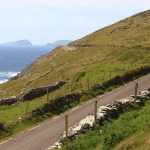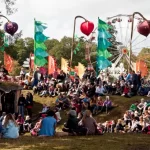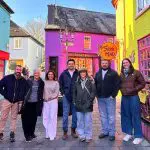Ireland is a land where storytelling runs deep. Despite having a relatively small population, Ireland has produced four Nobel Prize winners in Literature. And writers seem to occupy a unique role in Ireland. The nation has been both muse and mirror for her poets, novelists, and playwrights – the country has inspired the work, the work has in turn immortalised the country.
The following blog invites you to walk where they walked: To see the countryside that stirred Yeats’s poetry, the tower where Joyce lived and which features in the opening episode of Ulysses, the childhood home of Oscar Wilde, and the quiet parish where Seamus Heaney found his voice.
Whether you’re already well-versed in Irish literature or thinking of exploring some classics before a trip to the Emerald Isle, we hope this blog gives you plenty of inspiration! And if you’d like to enjoy a guided experience while in Ireland, be sure to explore our Small Group Tours of Ireland.

Dublin: Cradle of Irish Literary Greats
No city in Ireland or indeed the world is more deeply entwined with literary history than Dublin. The city serves as a character, a setting, and a muse in Irish writing, particularly in the work of James Joyce. However, Dublin’s literary roots stretch far wider, encompassing playwrights, poets, satirists, and novelists who drew both love and ire from their native city.
Begin your journey at the Museum of Literature Ireland (MoLI) on St Stephen’s Green. Housed in part of the original University College Dublin, where Joyce once studied, the museum is modern and immersive yet deeply rooted in tradition. Manuscripts, audio recordings, handwritten drafts, and first editions sit alongside interactive exhibits. There’s even a tranquil garden café – a perfect spot to sit and read!
Just around the corner lies Oscar Wilde’s childhood home, located across from the green space of Merrion Square. Though the house is not always open for tours, its exterior and the nearby statue of Wilde, lounging against a rock with raised eyebrows, make for a memorable stop. Surrounding stone pillars are engraved with some of his most cutting epigrams.
Wander on to Trinity College Dublin, alma mater to Wilde, Beckett, and Bram Stoker. Its grand library, particularly the Long Room, has become iconic. Here you can also visit the Book of Kells, a 9th-century illuminated manuscript that ranks among the most beautiful books ever made.
The James Joyce Centre, set in a preserved Georgian townhouse on North Great George’s Street, is a good base for walking tours and in-depth explorations. Smaller corners also offer up treats for Joyceans; for instance, Sweny’s Pharmacy, an old chemist’s shop immortalised in Ulysses – buy yourself a bar of lemon soap, just as Leopold Bloom did in the novel.

Sandycove: James Joyce’s Tower
Hop on a DART train south to the seaside town of Sandycove, where the literary trail continues in atmospheric fashion. Here you’ll find the Martello Tower, perched on a rocky outcrop overlooking Dublin Bay. In 1904, Joyce stayed briefly at the tower with his friend Oliver St. John Gogarty. That short stay became the dramatic opening scene of Ulysses.
Today, the tower is home to the James Joyce Tower and Museum, which is filled with first editions, letters, and other curious memorabilia, such as a tie that Samuel Beckett gifted to Joyce. The most striking part of a visit, though, is simply standing outside on top of the tower where Buck Mulligan made his famous entrance and looking out to sea, much as Stephen Dedalus does in the book.
The walk along the coast here is worth lingering over. The salty air, the rhythmic waves, the terns wheeling overhead. One can easily imagine why this stretch of shoreline held Joyce’s imagination for so long, even after he left Ireland behind and began his long exile in Italy, France, and Switzerland.

Sligo: In the Shadow of Benbulben with W.B. Yeats
If Dublin was the stage for Ireland’s urban modernists, then Sligo was the soul of its lyrical dreamers. For W.B. Yeats, Sligo wasn’t just a backdrop, it was a kind of spiritual homeland. Though he was born in Dublin, it was here, in the northwest corner of Ireland, that he found the myths, mountains, and mists that shaped his vision. Yes, this landscape inspired arguably the greatest poet of the 20th century.
Make your way to Drumcliffe Cemetery, a quiet, windswept graveyard at the foot of Benbulben. Yeats is buried here under a plain headstone etched with the famous epitaph: “Cast a cold eye / On life, on death / Horseman, pass by.” Benbulben looms above, conjuring images of ancient warriors and faerie folk – the folkloric elements that were so important in Yeats’ early work.
Nearby, you’ll find the Yeats Society Sligo, housed in the Yeats Memorial Building in the heart of town. It offers exhibits, readings, and summer schools for those who want to dig deeper. The centre also serves as a good launching point for a tour of “Yeats country” – take in Lough Gill (home to the “Lake Isle of Innisfree”), Glencar Waterfall, and Dooney Rock, all names that echo through his poems.

Derry: Seamus Heaney’s Moss-Grown World
Walk in the slow, earthy landscape of Bellaghy, a small village in County Derry where Seamus Heaney was born and now lies buried, and you might just find yourself developing a deeper understanding of his incredible poetry. His verse is full of bogs, fields, iron pumps, and butter churns, capturing the rhythms of rural life and turning them into quiet music. As Heaney said himself, his mid-20th-century childhood in Bellaghy was essentially indistinguishable from a medieval rural life. Here, you woke with sunrise and worked the land until nightfall, constantly accompanied by wildlife and the sounds of nature.
At the heart of this place-based legacy is the Seamus Heaney HomePlace, a centre dedicated to the poet’s life and work. It’s not a museum in the dusty sense of the word; rather, it’s a thoughtful, beautifully designed space that blends audio recordings, film, personal items, and original manuscripts. One room invites you to sit and listen as Heaney himself reads his poems aloud. Another offers a replica of the upstairs study where he wrote. Even the building’s stone façade seems to echo the turf walls and barn doors Heaney often described.
If you have the time, walk beyond the centre. The graveyard at St. Mary’s in Bellaghy, where Heaney is buried, is modest and unassuming. His headstone reads simply: “Walk on air against your better judgment.” It’s hard to imagine a more fitting invitation for readers who come seeking his presence.
If you would like our expert travel planners to craft a literary tour of Ireland for you, visit our Tailor-Made Tours of Ireland.

Galway & the West: Lady Gregory, Synge, and the Irish Revival
Head west to Coole Park, near Gort in County Galway, once the home of Lady Augusta Gregory, a playwright, folklorist, and co-founder of the Abbey Theatre. Her estate became a meeting place for Yeats, Synge, and other key figures in the Irish Literary Revival. Today, the grounds are open to the public, and the famous Autograph Tree, carved with the initials of her literary guests, still stands among the woods. Further out, the Aran Islands offer a glimpse into the remote, rugged life that captivated J.M. Synge, who drew inspiration here for The Playboy of the Western World and Riders to the Sea. Ferries from Galway or Doolin make it easy to visit for a day or longer. Our Ireland to Island 7-Day Tour features a visit to the atmospheric Aran Islands.
Cork: Frank O’Connor and Everyday Lives
Cork doesn’t trumpet its literary ties the way Dublin does, but it was home to Frank O’Connor, whose short stories captured the quiet trials and humour of Irish life with precision. While there’s no major museum, the Cork City Library holds a small archive, and the city’s energy – bright, musical, a little irreverent – still matches the tone of his work. If you are eager to explore Irish writing before your trip, a volume of Frank O’Connor’s matchless short stories is a fantastic place to start.

Other Irish Literary Sites Worth Visiting
In Listowel, County Kerry, John B. Keane’s Bar serves as both a functioning pub and a monument to rural Irish drama. Step inside for a pint and a story, because it is still run by his family.
Inniskeen, in County Monaghan, is the birthplace of Patrick Kavanagh. A modest visitor centre, walking trails, and the quiet River Fane all evoke the country life he captured so beautifully in his poetry.
And don’t forget about Bram Stoker, who is best known for Dracula. While he is most associated with London (and Transylvania!), he was actually born in Clontarf, Dublin. His early influences may surprise you, especially the gothic grandeur of Marsh’s Library, one of the oldest public libraries in Ireland.
Well, this brings a close to our bookish ramble about Ireland. Walking in the footsteps of Irish writers allows you to see Ireland in a different light – the country is a living library, with tales stretching from the early Irish myth cycles to the contemporary literary scene, which continues to produce award-winning novelists and playwrights.
So, what are you waiting for? Come and explore Ireland with us! Browse our Small Group Tours of Ireland.







